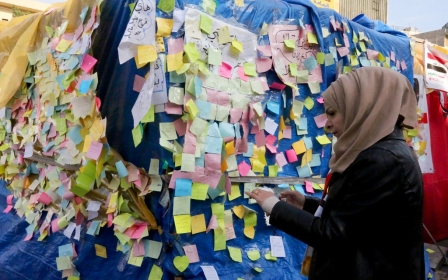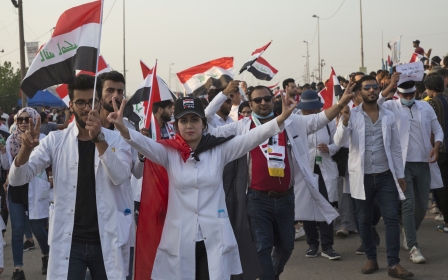If it wants to succeed, Iraq's protest movement needs to get organised
On 1 October, the Iraqi people returned to their protest sites to commemorate the first anniversary of the largest popular movement in Iraq’s modern history. The movement transcended local politics and entered the realm of the US-Iran conflict.
A year ago, calls for protests in Baghdad began to appear on social media, but they initially garnered little reaction from the people. Observers and researchers predicted that these appeals would result in, at most, a two-hour protest in Tahrir Square, before petering out. Even the government was not prepared for what happened next.
The protests have not achieved any 'goal' - nor will they, as the movement was not launched with clear goals in mind
The protests spread quickly, as scores of demonstrators began to appear in Baghdad’s main squares. Clashes broke out with security forces. At the time, protesters were lifting apolitical banners and slogans focused on services, job opportunities, accountability for corruption and the state’s arbitrary demolition of shops.
The government’s violent response, however, pushed protesters to demand reforms of the political system, with some calling for its downfall, along with a “fair” elections law and an end to political factions.
And yet, beyond Baghdad, the rallies spread across Iraq’s southern and central governorates. The death toll reached 560 people, according to Mustafa al-Kadhimi’s government, while thousands more were wounded. Authorities arrested some 2,800 protesters.
New MEE newsletter: Jerusalem Dispatch
Sign up to get the latest insights and analysis on Israel-Palestine, alongside Turkey Unpacked and other MEE newsletters
The Iraqi people were not expecting to witness such protests, at least not for the next decade. Their experience with the 2008-2011 protests, as well as the 2015 protests that I helped to lead, was one of disappointment and hijacking by political parties and activists. This caused people to lose their hopes of channeling protest calls on social media into popular anger on the streets.
Like any other political system that deals with its people in an obscure and non-transparent fashion, the Iraqi political establishment had no choice but to point the finger at other countries, accusing them of supporting activists to “destabilise” the country. But the incentives for protest and anger are deeply rooted in Iraq.
No clear goals
A year since their inception, however, the protests have not achieved any “goal” - nor will they, as the movement was not launched with clear goals in mind. It was essentially protest for the sake of protest. Demonstrators did have a broad list of demands, but they were unclear and were not presented to the government.
This ultimately weakened the protest movement. Street protests were characterised by disparate demands in each protest square, until violence erupted - and then the demands transformed into calls for the overthrow of the government of Adil Abdul-Mahdi. These calls went unheeded until Iraq’s top Shia leader, Ayatollah Ali al-Sistani, called for a change in leadership; Abdul-Mahdi stepped down last November.
The protests lacked political awareness, with many broaching unrealistic demands. Calls to end political parties in Iraq, for example, would take the country back to a dictatorship.
Some gains were made, as protesters disrupted the Iraqi political system, which is chained by political and sectarian quotas. But this disorder is not enough; without tangible changes on the ground, the blood of protesters will have been spilled in vain.
Iraqi political parties are now trying to convince protesters that the Kadhimi government represents them, even though it has failed to protect activists from killings and abductions.
On the contrary, under the Kadhimi government there has been an increase in attacks on activists, including the assassination of researcher Hisham al-Hashemi, which appeared to be a signal from armed groups to Kadhimi that they can target those in his inner circle if he infringes upon their interests.
US-Iran tensions
The US-Iran conflict has also had a significant impact on protests in Iraq. Iran’s anti-protest position was met by opposing forces from the US in defence of protesters, spurring increased attacks and incitement against protesters by Iranian government media and armed groups, which tried to violently suppress demonstrations. We saw that such attacks increased as the conflict between Washington and Tehran escalated.
Sistani could be considered the shield that protected and supported the protests, declaring his support for them and urging the Abdul-Mahdi government to meet the movement’s demands. Sistani, who has also supported major protests in previous years, is essentially Iraq’s buffer against the expansion of the Iranian project; without him, the crackdown against demonstrators would surely have been even more extreme.
Sistani attempted to get closer to protesters, even though they let him down in 2015 by handing protests over to the Sadrist movement, according to a close associate who convened the first meeting between protesters and Sistani’s office in 2015, at which I was also present.
Yet, despite Sistani’s support, some demonstrators blame him for maintaining what they see as a doveish position in the face of serious crimes committed against them. His close associate told me in December: “We do not move the street. Rather, the street moves us, and whenever the protesters escalate their rhetoric, we will escalate our speech.”
Kadhimi’s government, on the other hand, neither represents the protesters, nor governs the protests; rather, it is a government that came to power because of popular anger. On a practical level, it is not close to the street movement, and it has taken on more responsibilities than it should. As a transitional government facing specific tasks, it has acted with haste in proposing a government programme that tackles the most prominent and dangerous issues, including corruption and arms control.
Anti-Kadhimi sentiments
Kadhimi has tried to win over protesters by positioning himself against armed groups, but he has not succeeded. There is no positive relationship between Kadhimi and activists, who believe that as the former head of the Iraqi National Intelligence Service, Kadhimi let them down during past crackdowns. It is thus expected that they will shout slogans and lift banners against him in the coming days.
Iraq's popular movement cannot be relied upon unless it turns into real political action
Protesters are now preparing for 25 October, a bloody day that they consider to be the real start of the protests, in which dozens of people were injured or killed.
But Iraq’s popular movement cannot be relied upon unless it turns into real political action. Protests and acts of violence will not bear fruit unless there are authentic political currents emerging from the heart of the protests.
The success of the protest movement, as Iraqi researcher Harith Hasan pointed out, relies on its ability to develop a cohesive agenda for the future, and to turn the street mobilisation into an organised political force.
Protesters are demanding the introduction of an electoral system that will not reproduce the current political class, and end the apportionment of state positions and resources on sectarian lines.
The movement needs enough time to build itself up and gain wider popular support, in preparation for the 2025 elections. Participating in next June’s elections may be too soon to make groundbreaking changes.
The views expressed in this article belong to the author and do not necessarily reflect the editorial policy of Middle East Eye.
Middle East Eye delivers independent and unrivalled coverage and analysis of the Middle East, North Africa and beyond. To learn more about republishing this content and the associated fees, please fill out this form. More about MEE can be found here.







